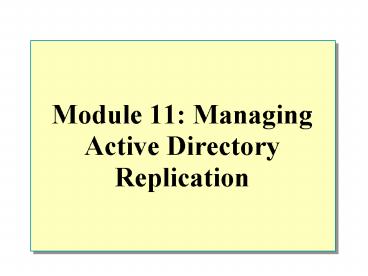Module 11: Managing Active Directory Replication - PowerPoint PPT Presentation
1 / 34
Title:
Module 11: Managing Active Directory Replication
Description:
Redmond-Site. Subnets. DENVER. NTDS Settings. Replication ... Redmond-Site. IP Subnet. Domain Controller B. IP Subnet. Creating and Configuring Site Links ... – PowerPoint PPT presentation
Number of Views:143
Avg rating:3.0/5.0
Title: Module 11: Managing Active Directory Replication
1
Module 11 Managing Active Directory Replication
2
Overview
- Introduction to Active Directory Replication
- Replication Components and Processes
- Replication Topology
- Using Sites to Optimize Active Directory
Replication - Implementing Sites to Manage Active Directory
Replication - Monitoring Replication Traffic
- Adjusting Replication
- Troubleshooting Active Directory Replication
- Best Practices
3
Introduction to Active Directory Replication
4
Replication Components and Processes
- How Replication Works
- Replication Latency
- Resolving Replication Conflicts
- Optimizing Replication
5
How Replication Works
- Active Directory Update
- Move
- Delete
- Add
- Modify
6
Replication Latency
7
Resolving Replication Conflicts
8
Optimizing Replication
9
Replication Topology
- Directory Partitions
- What Is Replication Topology?
- Global Catalog and Replication of Partitions
- Automatic Replication Topology Generation
- Using Connection Objects
10
Directory Partitions
11
What Is Replication Topology?
12
Global Catalog and Replication of Partitions
13
Automatic Replication Topology Generation
14
Using Connection Objects
- Connection Objects Are Created Automatically or
Manually - Connection Objects Are Created on Each Domain
Controller - Use Active Directory Sites and Services to
Manually Create, Delete, and Adjust Connection
Objects - Use the Replicate Now Option to Manually Initiate
Replication
Connection Object
Connection Object
Domain Controller A1
Domain Controller A2
15
Lab A Tracking Active Directory Replication
16
Using Sites to Optimize Active Directory
Replication
- What Are Sites?
- Replication Within Sites
- Replication Between Sites
- Replication Protocols
17
What Are Sites?
- The First Site Is Set Up Automatically, and Is
Called Default-First-Site-Name - Sites Can Consist of Zero, One, or More Subnets
- Sites Are Used to Control Replication Traffic and
Logon Traffic - Sites Contain Server Objects and Are Associated
with IP Subnet Objects
18
Replication Within Sites
- Replication Within Sites
- Occurs Between Domain Controllers in the Same
Site - Assumes Fast and Highly Reliable Network Links
- Does Not Compress Replication Traffic
- Uses a Change Notification Mechanism
19
Replication Between Sites
ISTG
Bridgehead Server
- Replication Between Sites
- Occurs on a Manually Defined Schedule
- Is Designed to Optimize Bandwidth
- One or More Replicas in Each Site Act As
Bridgeheads
Replication
IP Subnet
IP Subnet
Site
Replication
Replication
Bridgehead Server, ISTG
IP Subnet
IP Subnet
Site
20
Replication Protocols
21
Implementing Sites to Manage Active Directory
Replication
- Creating Sites and Subnets
- Creating and Configuring Site Links
- Creating a Site Link Bridge
22
Creating Sites and Subnets
23
Creating and Configuring Site Links
- Site Links Are Defined by
- Transport
- Member sites
- Cost
- Schedule
- Replication Interval
24
Creating a Site Link Bridge
25
Lab B Using Sites to Manage Active Directory
Replication
26
Monitoring Replication Traffic
- What Is Replication Monitor?
- Using Replication Monitor to Monitor Replication
Traffic - Using Repadmin to Monitor Replication Traffic
27
What Is Replication Monitor?
- Display the Replicating Partner
- Display Each USN Value, the Number of Failed
Attempts, Reason, and Flags - Poll the Server at an Administrator-Defined
Interval - Monitor the Count of Failed Replication Attempts
- Show Which Objects Have Not Yet Replicated
- Synchronize Between Just Two Domain Controllers
- Trigger the KCC into Recalculating the
Replication Topology
28
Using Replication Monitor to Monitor Replication
Traffic
29
Using Repadmin to Monitor Replication Traffic
30
Adjusting Replication
- Creating Additional Connection Objects to
- Reduce the number of hops between domain
controllers - Bypass the failed server or servers
- Configuring Preferred Bridgehead Servers
31
Lab C Monitoring Replication
32
Troubleshooting Active Directory Replication
33
Best Practices
34
Review
- Introduction to Active Directory Replication
- Replication Components and Processes
- Replication Topology
- Using Sites to Optimize Active Directory
Replication - Implementing Sites to Manage Active Directory
Replication - Monitoring Replication Traffic
- Adjusting Replication
- Troubleshooting Active Directory Replication
- Best Practices































